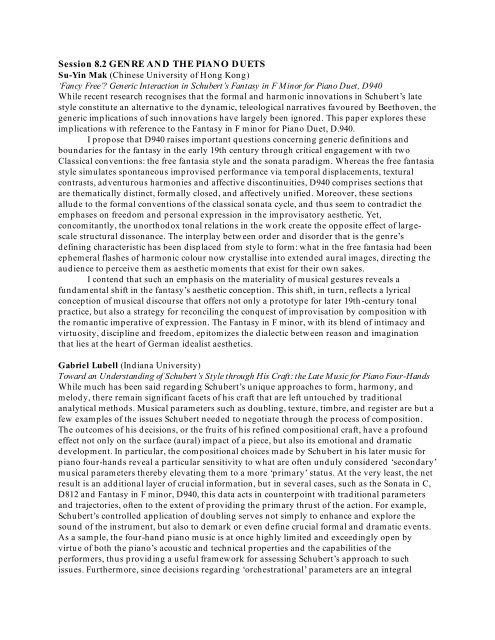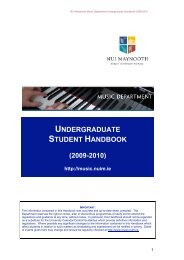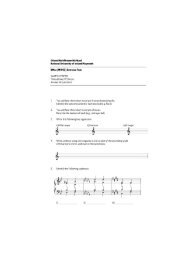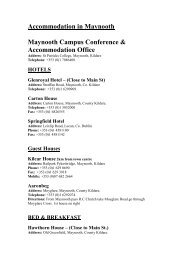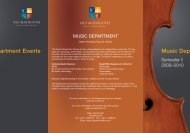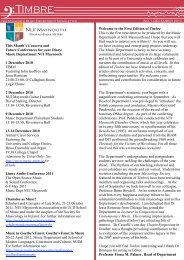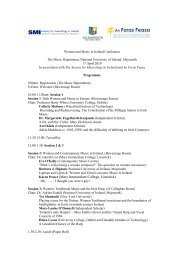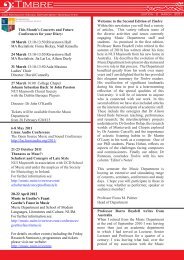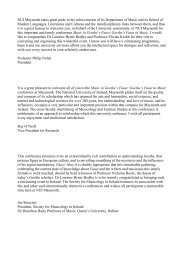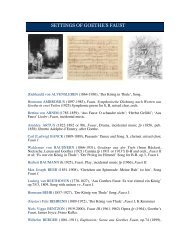Conference Booklet - Music - National University of Ireland, Maynooth
Conference Booklet - Music - National University of Ireland, Maynooth
Conference Booklet - Music - National University of Ireland, Maynooth
You also want an ePaper? Increase the reach of your titles
YUMPU automatically turns print PDFs into web optimized ePapers that Google loves.
Session 8.2 GENRE AND THE PIANO DUETS<br />
Su-Yin Mak (Chinese <strong>University</strong> <strong>of</strong> Hong Kong)<br />
‘Fancy Free’? Generic Interaction in Schubert’s Fantasy in F Minor for Piano Duet, D940<br />
While recent research recognises that the formal and harmonic innovations in Schubert‘s late<br />
style constitute an alternative to the dynamic, teleological narratives favoured by Beethoven, the<br />
generic implications <strong>of</strong> such innovations have largely been ignored. This paper explores these<br />
implications with reference to the Fantasy in F minor for Piano Duet, D.940.<br />
I propose that D940 raises important questions concerning generic definitions and<br />
boundaries for the fantasy in the early 19th century through critical engagement with two<br />
Classical conventions: the free fantasia style and the sonata paradigm. Whereas the free fantasia<br />
style simulates spontaneous improvised performance via temporal displacements, textural<br />
contrasts, adventurous harmonies and affective discontinuities, D940 comprises sections that<br />
are thematically distinct, formally closed, and affectively unified. Moreover, these sections<br />
allude to the formal conventions <strong>of</strong> the classical sonata cycle, and thus seem to contradict the<br />
emphases on freedom and personal expression in the improvisatory aesthetic. Yet,<br />
concomitantly, the unorthodox tonal relations in the work create the opposite effect <strong>of</strong> largescale<br />
structural dissonance. The interplay between order and disorder that is the genre‘s<br />
defining characteristic has been displaced from style to form: what in the free fantasia had been<br />
ephemeral flashes <strong>of</strong> harmonic colour now crystallise into extended aural images, directing the<br />
audience to perceive them as aesthetic moments that exist for their own sakes.<br />
I contend that such an emphasis on the materiality <strong>of</strong> musical gestures reveals a<br />
fundamental shift in the fantasy‘s aesthetic conception. This shift, in turn, reflects a lyrical<br />
conception <strong>of</strong> musical discourse that <strong>of</strong>fers not only a prototype for later 19th -century tonal<br />
practice, but also a strategy for reconciling the conquest <strong>of</strong> improvisation by composition with<br />
the romantic imperative <strong>of</strong> expression. The Fantasy in F minor, with its blend <strong>of</strong> intimacy and<br />
virtuosity, discipline and freedom, epitomizes the dialectic between reason and imagination<br />
that lies at the heart <strong>of</strong> German idealist aesthetics.<br />
Gabriel Lubell (Indiana <strong>University</strong>)<br />
Toward an Understanding <strong>of</strong> Schubert’s Style through His Craft: the Late <strong>Music</strong> for Piano Four-Hands<br />
While much has been said regarding Schubert‘s unique approaches to form, harmony, and<br />
melody, there remain significant facets <strong>of</strong> his craft that are left untouched by traditional<br />
analytical methods. <strong>Music</strong>al parameters such as doubling, texture, timbre, and register are but a<br />
few examples <strong>of</strong> the issues Schubert needed to negotiate through the process <strong>of</strong> composition.<br />
The outcomes <strong>of</strong> his decisions, or the fruits <strong>of</strong> his refined compositional craft, have a pr<strong>of</strong>ound<br />
effect not only on the surface (aural) impact <strong>of</strong> a piece, but also its emotional and dramatic<br />
development. In particular, the com positional choices made by Schubert in his later music for<br />
piano four-hands reveal a particular sensitivity to what are <strong>of</strong>ten unduly considered ‗secondary‘<br />
musical parameters thereby elevating them to a more ‗primary‘ status. At the very least, the net<br />
result is an additional layer <strong>of</strong> crucial information, but in several cases, such as the Sonata in C,<br />
D812 and Fantasy in F minor, D940, this data acts in counterpoint with traditional parameters<br />
and trajectories, <strong>of</strong>ten to the extent <strong>of</strong> providing the primary thrust <strong>of</strong> the action. For example,<br />
Schubert‘s controlled application <strong>of</strong> doubling serves not simply to enhance and explore the<br />
sound <strong>of</strong> the instrument, but also to demark or even define crucial formal and dramatic events.<br />
As a sample, the four-hand piano music is at once highly limited and exceedingly open by<br />
virtue <strong>of</strong> both the piano‘s acoustic and technical properties and the capabilities <strong>of</strong> the<br />
performers, thus providing a useful framework for assessing Schubert‘s approach to such<br />
issues. Furthermore, since decisions regarding ‗orchestrational‘ parameters are an integral


